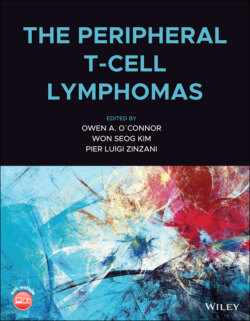Читать книгу The Peripheral T-Cell Lymphomas - Группа авторов - Страница 48
Introduction
ОглавлениеThere is no other disease for which the constellation of data and evidence points toward the conclusion that T‐cell lymphomas (TCLs) may represent the prototypical malignant disease characterized by gross epigenetic derangements and vulnerability. This sentiment is driven by a number of observations. First, around the world, there are now four histone deacetylases (HDACs) approved as single agents for the disease. These drugs appear to exhibit a class effect and, at least as single agents, have yet to demonstrate the same degree of clinical benefit in any other disease. Second, emerging data have identified a host of derangements in important epigenetic genes which play a critical role in governing gene transcriptions. These genes, including but not limited to DNMT3, IDH2, and TET2 for example, can profoundly alter DNA methylation, though these derangements are not prevalent across all subtypes of peripheral TCL (PTCL). Third, several experimental lines of evidence suggest that combinations of select mutated epigenetic genes, like TET2, coupled with recurring mutations in RhoA, can recapitulate certain types of TCL, in particular angioimmunoblastic TCL (AITL). Last, combinations of drugs targeting various epigenetic derangements predicated on HDAC inhibitors and hypomethylating agents (HMA), are producing responses and durations of response that appear promising. Synthesizing and interpreting these seemingly divergent lines of data are likely to offer an unprecedented opportunity to leverage this unique biology and pharmacology to in a manner which can have important impact on our ability to diagnose, prognosticate and ultimately treat these challenging diseases. Below, we review these data, and describe how this information may be used to better understand the T‐cell malignancies.
